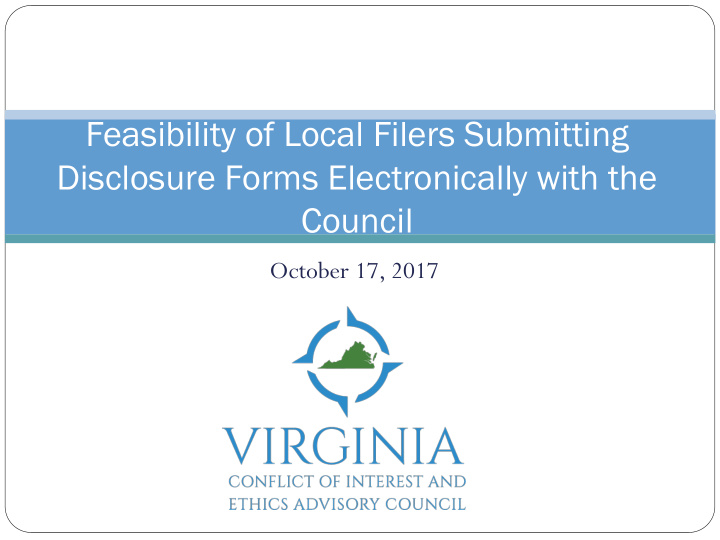



Feasibility of Local Filers Submitting Disclosure Forms Electronically with the Council October 17, 2017
Overview Background: SJR 289 (2017) Analysis costs and resources practical considerations policy considerations Options for Final Conclusion Discussion 2
Background 3
Background During the Regular Session of the 2017 General Assembly, Senator Ebbin introduced Senate Joint Resolution 289. The main focus of this study resolution was to “determine the feasibility of the Council accepting disclosure forms from local government officers and employees in its current electronic filing system.” 4
Background The resolution was passed by indefinitely in the Senate Rules Committee, with a letter request sent to the Council to study the subject matter of the resolution. 5
Background Currently, legislators, state officers and employees, and constitutional officers who are required to file a disclosure form submit their forms to the Council, via the Council’s online filing system. (Va. Code §§ 2.2-3114(C), 2.2-3116, 30-110 (A), 30- 356 (3). Local officers and employees who are required to file a disclosure form submit their forms to the clerk of the respective governing body or school board. (Va. Code § 2.2-3115(D)). 6
Background The Council’s filing system receives approximately 12,000 forms per year from legislators, state officers and employees, and constitutional officers. This does not include lobbyist disclosure forms filed with the Council. If the Council were to receive all local and school board filings as well, it is estimated that would result in an additional 6,000 filings per year, at minimum. 7
Analysis 8
Analysis: costs and resources • In order to accommodate local filings, the Council’s filing system would need to have three additional forms incorporated: the local versions of the Statement of Economic Interests and the Financial Disclosure Statement, as well as the Disclosure of Real Estate Holdings. • The current system would also need upgrading — additional allocated disk space and memory. 9
Analysis: costs and resources • The Council’s electronic system would need to have its email notification systems modified and expanded. • Adjustments would also need to be made in order to handle the addition of between 500 and 1,000 filing coordinators, representing an additional 600 to 1,000 local boards, commissions, and other entities. 10
Analysis: costs and resources • The Division of Legislative Automated Systems (DLAS) has advised that this increase in the number of filers using the Council’s system would result in increased resource needs. • They have provided a preliminary estimate of $1,000 to upgrade servers. • Developing the additional software would be a nine month project; since DLAS has time constraints due to other projects, they would recommend partnering with an outside developer, as they did in the autumn of 2016. • Estimated cost would be approximately $180,000. 11
Analysis: costs and resources • These estimates from DLAS do not include any of their own computer resources or staff time for the development of an expanded Council filing system . 12
Analysis: costs and resources • To accommodate the additional phone calls, emails, and research generated by all of the additional filers, the Council would need to hire additional staff. • The anticipated workload likely would require two FTEs. • One attorney and one filing coordinator would handle state filers, and one attorney and one filing coordinator would be dedicated to local filers. 13
Analysis: practical considerations • Because of the required electronic filing, all local clerks and all clerks of school boards would have to designate someone in their office to be the filing coordinator for their filers. • Some clerks might also request the clerks of separate local and regional boards (e.g., an economic development authority or a zoning board) to have their own filing coordinators. 14
Analysis: practical considerations • All of the additional filing coordinators would need to be added to the Council’s system. • Council staff would need to conduct a series of informational trainings across the state on changes to the law and to introduce clerks to the role and duties of filing coordinators. • Trainings would also need to be offered to new filing coordinators on how to use the Council’s system. 15
Analysis: practical considerations • Adequate preparation time would be needed to ensure a smooth transition away from local filing to filing with the Council electronically . • If this change were to be approved by the General Assembly, a realistic completion date for all of the preparatory projects would be 2020; the first online filings by local officials and employees would then be January of 2021. 16
Analysis: policy considerations • Enforcing and collecting the civil penalties for failing to file by established deadlines is currently the responsibility of Commonwealth’s Attorneys for local filers, and the responsibility of the Attorney General for state filers. • The Council is required to notify the Attorney General of all state officers and employees who failed to file on time within 30 days after the deadline. • (Va. Code § 2.2-3124(B)). • If all local disclosures are to be filed with the Council instead of with local clerks, would enforcement remain with the Commonwealth’s Attorneys? 17
Analysis: policy considerations • To use the Council’s online filing system, the filer must have a computer with Internet access. Will all local filers be receptive to switching from paper forms to using the Internet? • If this change were to be made, paper filings or filing using email attachments would no longer be options for local filers. 18
Final Conclusion • Staff recommends that at the current time, local officials and employees should continue to file with their local clerks. 19
20 Discussion
Recommend
More recommend